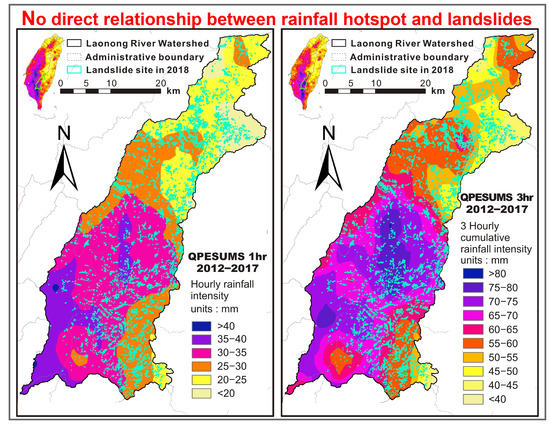Application of High-Resolution Radar Rain Data to the Predictive Analysis of Landslide Susceptibility under Climate Change in the Laonong Watershed, Taiwan
Abstract
1. Introduction
2. Materials and Methods
2.1. Research Area
2.2. Rainfall Data Sources and Classification
2.3. Interpretation of Landslide Areas and Analysis of Their Changes
2.3.1. Landslide Inventory
2.3.2. Multitemporal Changes in Landslide Areas and Extraction of Explanatory Factors
2.4. Establishment of the Landslide Susceptibility Model
2.4.1. Model and Factor Selection
- Elevation (unit: meters): The altitude above sea level is directly calculated from the DEM for all of Taiwan with a 20 m resolution provided by the Ministry of the Interior.
- Slope (unit: degrees): Calculated from the DEM data of the Ministry of the Interior with the 20 m resolution by using ArcGIS 10.7 (Spatial Analyst of extension tool).
- Topographic roughness (unit: meters): The degree of topographic change in the area. Topographic roughness is calculated by using ArcGIS 10.7, with the standard deviation of the elevation values in a circular window (3 × 3 pixel, moving window) as a measure of the degree of elevation variation in the area [39]. A schematic diagram of the circular window is shown in Figure 2, and the standard deviation (SD) is calculated as follows:where SDh is the topographic roughness, nc is the number of points within the window, Zi is the elevation value of each point, and is the mean value of the elevation of each point within the window.
- Slope roughness (unit: degrees): The variations of slope within the area. Using the slope roughness, it is possible to find out whether a landslide would occur in the landscape with drastic slope variations. The calculation method and tool are the same as the topographic roughness, and is calculated as follows:where SDs is the slope roughness, nc is the number of points within the window, Zi is the slope value of each point, and is the mean value of the slope of each point within the window.
- Aspect sine value and cosine value (unitless): There will be numerical discontinuities if the aspect is expressed as an angle (e.g., 0° = 360°), and thus the aspect can be decomposed into an X vector and a Y vector, i.e., the aspect sine value and aspect cosine value, respectively. A positive sine value indicates the degree to the east, and a negative sine value indicates the degree to the west, a positive cosine value indicates the degree to the north, and a negative cosine value indicates the degree to the south. The value can be calculated from the DEM data by using ArcGIS 10.7 (Spatial Analyst of extension tool).
- NDVI before landslides (unitless): NDVI is the most common index for evaluating the surface vegetation status in an area [40,41,42,43]. The NDVI value before the flood season can be used as a quantitative value for the vegetation status before landslides. It was calculated from SPOT satellite imagery by Erdas Imagine 4.0.
- Maximum accumulated rainfall in 24 h (unit: mm): In previous studies, it was often believed that rainfall intensity is related to landslide events [44,45]. However, the choice of rainfall intensity differed based on the different regions or research objectives. In previous studies on rainfall thresholds for landslides in southwestern Taiwan, the accumulated rainfall in 6, 12, 24, 48, and 72 h in autumn during different years was adopted in the variance analysis, and it was found that the 24 h accumulated rainfall had the lowest variation coefficient [46], i.e., the internal changes and differences in data corresponding to the 24 h accumulated rainfall are relatively small. The rainfall value is calculated by the Kriging method.
- Topographic wetness index (TWI, unit: m2): The ability of the terrain to control soil moisture. The steeper the slope, the faster the runoff speed, the lower the degree of infiltration, and thereby, the lower the soil moisture content [47]. Because the watershed area is relatively large and the slope is mild in low and flat areas, the soil water content is relatively high. If the water content under the slope is large, the pore water pressure of soil increases, and the soil is affected by the lifting force of water. The value can be calculated by using ArcGIS 10.7. As a result, the probability of slope failure and sliding becomes higher, and is expressed as follows:where ω is the TWI, As is the watershed area above a certain point, and θ is the slope.
- Geology (unitless): Different geological conditions affect the strength of rock mass, joint density, joint structures, etc. We used the local geological formations (Figure 1) as a categorical variable in the model. The data are transferred from vector data to grid data.
- Distance to the river (unit: meters): The distance from any point to the river. Landslides may occur on both sides of the riverbank. Continuous erosion on the foundation slope makes the area unstable, and a landslide is likely to occur during high-intensity rainfall. The distance from the river channel is obtained by analysis using ArcGIS 10.7 (path distance), which is to calculate the flow path from the river channel to the landslide.
2.4.2. Model Calibration and Validation
Model Calibration
Model Validation
2.4.3. Landslide Risk and Critical Rainfall under Different Rainfall Scenarios
3. Results
3.1. Long-Term Rainfall Variations
3.2. The Multitemporal Changes in Landslide Areas
3.3. Landslide Susceptibility Model and Explanatory Factors
4. Discussion
4.1. Rainfall Hot Spots and Landslides
4.2. Landslide Risk Ranking and Simulation of Critical Rainfall Scenarios
5. Conclusions
Author Contributions
Funding
Acknowledgments
Conflicts of Interest
References
- Yu, P.-S.; Yang, T.-C.; Kuo, C.-C. Evaluating long-term trends in annual and seasonal precipitation in Taiwan. Water Resour. Manag. 2006, 20, 1007–1023. [Google Scholar] [CrossRef]
- Liu, H.Y.; Gao, J.X.; Li, Z.G. The advances in the application of remote sensing technology to the study of land covering and land utilization. Remote Sens. Land Resour. 2009, 4, 7–12. [Google Scholar]
- Tu, J.; Chou, C. Changes in precipitation frequency and intensity in the vicinity of Taiwan: Typhoon versus non-typhoon events. Environ. Res. Lett. 2013, 8, 014023. [Google Scholar] [CrossRef]
- Derin, Y.; Anagnostou, E.; Berne, A.; Borga, M.; Boudevillain, B.; Buytaert, W.; Chang, C.-H.; Chen, H.; Delrieu, G.; Hsu, Y.C.; et al. Evaluation of GPM-era global satellite precipitation products over multiple complex terrain regions. Remote Sens. 2019, 11, 2936. [Google Scholar] [CrossRef]
- Chang, K.-J.; Tseng, C.-W.; Tseng, C.-M.; Liao, T.-C.; Yang, C.J. Application of unmanned aerial vehicle (uav)-acquired topography for quantifying typhoon-driven landslide volume and its potential topographic impact on rivers in mountainous catchments. Appl. Sci. 2020, 10, 6102. [Google Scholar] [CrossRef]
- Soden, B.J.; Held, I.M. An assessment of climate feedbacks in coupled ocean–atmosphere models. J. Clim. 2006, 19, 3354–3360. [Google Scholar] [CrossRef]
- Vecchi, G.A.; Soden, B.J. Global warming and the weakening of the tropical circulation. J. Clim. 2007, 20, 4316–4340. [Google Scholar] [CrossRef]
- Chou, C.; Tu, J.-Y.; Tan, P.-H. Asymmetry of tropical precipitation change under global warming. Geophys. Res. Lett. 2007, 34, 17708. [Google Scholar] [CrossRef]
- Sun, Y.; Solomon, S.; Dai, A.; Portmann, R.W. How often will it rain? J. Clim. 2007, 20, 4801–4818. [Google Scholar] [CrossRef]
- Chou, C.; Chiang, J.C.H.; Lan, C.-W.; Chung, C.-H.; Liao, Y.-C.; Lee, C.-J. Increase in the range between wet and dry season precipitation. Nat. Geosci. 2013, 6, 263–267. [Google Scholar] [CrossRef]
- Huang, P.; Xie, S.-P.; Hu, K.; Huang, G.; Huang, R. Patterns of the seasonal response of tropical rainfall to global warming. Nat. Geosci. 2013, 6, 357–361. [Google Scholar] [CrossRef]
- Tan, C.-C.; Tung, C.-P. Climate change impacts on Taipei groundwater recharge. J. Taiwan Agric. Eng. 2008, 54, 1–15. [Google Scholar]
- National Science and Technology Center for Disaster Reduction. Disaster Survey and Analysis of Morakot Typhoon; research project 2010; National Science Council: Taipei, Taiwan, 2010. (In Chinese) [Google Scholar]
- Chung, Y.-C. Probe into the Regional Landslide Susceptibility Analysis—A Case Study in the Shimen Reservoir Catchment Area. Master’s Thesis, Department of Earth Sciences, National Central University, Tainan, Taiwan, 2009. (In Chinese). [Google Scholar]
- Wei, L.-W.; Huang, C.-M.; Huang, W.-K.; Lee, C.-F.; Chi, C.-C. Development and Application of Rainfall Triggered Landslides Warning Information System. Sinotech Eng. 2018, 57–67. (In Chinese). Available online: https://www.sinotech.org.tw/journal/Abstract/?n=303 (accessed on 22 October 2020). (In Chinese).
- Wu, C.-H.; Chen, S.-C. The evaluation of the landslide potential prediction models used in Taiwan. J. Soil Water Conserv. 2004, 36, 295–306. (In Chinese) [Google Scholar]
- Fang, Y.M.; Hung, P.S.; Cheng, M.Y.; Yu, P.S.; Huang, M.H.; Huang, Y.H. Study on the establishment of slope collapse monitoring and early warning model of Suhua highway. Harb. Rep. 2012, 92, 32–38. (In Chinese) [Google Scholar] [CrossRef]
- Chen, C.-Y.; Chen, J.-W.; Chen, K.-W.; Lin, Y.-C. Warning Model for Predicting the Risk Zones of Rainfall-Induced Slopeland Disasters. J. Chin. Soil Water Conserv. 2019, 50, 1–10. (In Chinese) [Google Scholar]
- Chang, L.-C.; Chiang, Y.-M.; Tsai, M.-J.; Shieh, M.-C.; Hsu, K.; Sorooshian, S. Watershed rainfall forecasting using neuro-fuzzy networks with the assimilation of multi-sensor information. J. Hydrol. 2014, 508, 374–384. [Google Scholar] [CrossRef]
- Youssef, A.M.; Pourghasemi, H.R. Landslide susceptibility mapping using machine learning algorithms and comparison of their performance at Abha Basin, Asir Region, Saudi Arabia. Geosci. Front. 2020. [Google Scholar] [CrossRef]
- Lin, G.-F.; Chang, M.-J.; Huang, Y.-C.; Ho, J.-Y. Assessment of susceptibility to rainfall-induced landslides using improved self-organizing linear output map, support vector machine, and logistic regression. Eng. Geol. 2017, 224, 62–74. [Google Scholar] [CrossRef]
- Zhao, Y.; Wang, R.; Jiang, Y.; Liu, H.; Wei, Z. GIS-based logistic regression for rainfall-induced landslide susceptibility mapping under different grid sizes in Yueqing, Southeastern China. Eng. Geol. 2019, 259, 105147. [Google Scholar] [CrossRef]
- Hemasinghe, H.; Rangali, R.; Deshapriya, N.; Samarakoon, L. Landslide susceptibility mapping using logistic regression model (a case study in Badulla District, Sri Lanka). Procedia Eng. 2018, 212, 1046–1053. [Google Scholar] [CrossRef]
- Lin, M.-L.; Chen, T.-W.; Lin, C.-W.; Ho, D.-J.; Cheng, K.-P.; Yin, H.-Y.; Chen, M.-C. Detecting large-scale landslides using lidar data and aerial photos in the Namasha-Liuoguey area, Taiwan. Remote Sens. 2013, 6, 42–63. [Google Scholar] [CrossRef]
- Wu, C. Comparison and evolution of extreme Rainfall-Induced landslides in Taiwan. ISPRS Int. J. Geo Inf. 2017, 6, 367. [Google Scholar] [CrossRef]
- Lin, J.-C. Top. Ten Geographical Issues in Taiwan; Book Republic Publishing Group: Taipei, Taiwan, 2008. [Google Scholar]
- Liang, F.-W. A Study of Landslide Susceptibility Analysis vs Rainfall at Lao-Nong River Watershed. Master’s Thesis, Department of Soil and Water Conservation, National Chung Hsing University, Taichung, Taiwan, 2014. (In Chinese). [Google Scholar]
- Chen, C.-H.; Lin, C.-W.; Chen, M.-M.; Chang, W.-S.; Liu, S.-H. A landslide study by using multi-temporal satellite images: An example from Lao-Lung River watershed. J. Taiwan Disaster Prev. Soc. 2011, 3, 25–38. (In Chinese) [Google Scholar]
- Hung, Y.-W. The Engineering Geological Characteristics and Triggered Mechanism of Debris Flow in the Chishan River and Laonong River of Kaohsiung. Master’s Thesis, Department of Geosciences, National Taiwan University, Taipei, Taiwan, 2014. (In Chinese). [Google Scholar]
- Tseng, M.-C. Analysis of Topographic Signatures after Typhoon Morakot-Take Watershed of Southern Taiwan as Examples. Master’s Thesis, Department of Land Management and Development, Chang Jung Christian University, Tainan, Taiwan, 2012. (In Chinese). [Google Scholar]
- Chen, T.-C.; Wu, C.-C.; Weng, M.-C.; Hsieh, K.-H.; Wang, C.-C. Slope Failure of Lawnon Basin Induced by Typhoon Morakot. Sino Geotech. 2009, 122, 13–20. (In Chinese) [Google Scholar]
- Wei, C.-C.; Hsieh, P.-Y. Estimation of hourly rainfall during typhoons using radar mosaic-based convolutional neural networks. Remote Sens. 2020, 12, 896. [Google Scholar] [CrossRef]
- Xin, L.; Reuter, G.; Larochelle, B. Reflectivity-rain rate relationships for convective rain showers in Edmonton: Research note. Atmos. Ocean 1997, 35, 513–521. [Google Scholar] [CrossRef]
- Tang, Y.-S.; Chang, P.-L. QPESUMS development and customized services. In Proceedings of the Symposium on Weather Analysis and Forecasting, Central Weather Bureau, Taipei, Taiwan, 15–16 September 2015; pp. A6–A9. [Google Scholar]
- Lin, E.-J.; Liu, C.-C.; Chang, C.-H.; Cheng, I.-F.; Ko, M.-H. Using The FORMOSAT-2 High Spatial and Temporal Resolution Multispectral Image for Analysis and Interpretation Landslide Disasters in Taiwan. J. Photogramm. Remote Sens. 2013, 17, 31–51. [Google Scholar]
- Lin, S.-C.; Chuang, C.-W.; Ho, S.-H.; Lin, C.-Y. Effect of the vegetation index on the accuracy of image classification. J. Soil Water Conserv. 2008, 40, 181–193. [Google Scholar]
- Chang, K.; Chiang, S.-H.; Hsu, M.-L. Modeling typhoon- and earthquake-induced landslides in a mountainous watershed using logistic regression. Geomorphology 2007, 89, 335–347. [Google Scholar] [CrossRef]
- Agresti, A. Categorical Data Analysis, 2nd ed.; John Wiley: New York, NY, USA, 2002; 710 p. [Google Scholar]
- Wilson, J.P.; Gallant, J.C. Terrain Analysis: Principles and Applications; John Wiley & Sons: Hoboken, NJ, USA, 2000. [Google Scholar]
- Lillesand, T.; Kiefer, R.W.; Chipman, J. Remote Sensing and Image Interpretation; John Wiley and Sons: Hoboken, NJ, USA, 2015. [Google Scholar]
- Rouse, J.W.; Haas, H.R.; Schell, J.A.; Deering, D.W. Monitoring vegetation systems in the Great Plains with ERTS. In Proceedings of the Third ERTS Symposium, NASA SP-351 I, Washington, DC, USA, 10–14 December 1973; US Government Printing Office: Washington, DC, USA; pp. 309–317. [Google Scholar]
- Bosino, A.; Giordani, P.; Quénéhervé, G.; Maerker, M. Assessment of calanchi and rill–interrill erosion susceptibilities using terrain analysis and geostochastics: A case study in the Oltrepo Pavese, Northern Apennines, Italy. Earth Surf. Process. Landf. 2020, 45, 3025–3041. [Google Scholar] [CrossRef]
- Cama, M.; Schillaci, C.; Kropáček, J.; Hochschild, V.; Bosino, A.; Maerker, M. A Probabilistic Assessment of Soil Erosion Susceptibility in a Head Catchment of the Jemma Basin, Ethiopian Highlands. Geosciences 2020, 10, 248. [Google Scholar] [CrossRef]
- Keefer, D.K.; Wilson, R.C.; Mark, R.K.; Brabb, E.E.; Brown, W.M.; Ellen, S.D.; Harp, E.L.; Wieczorek, G.F.; Alger, C.S.; Zatkin, R.S. Real-time landslide warning during heavy rainfall. Science 1987, 238, 921–925. [Google Scholar] [CrossRef]
- Dai, F.; Lee, C. Frequency–volume relation and prediction of rainfall-induced landslides. Eng. Geol. 2001, 59, 253–266. [Google Scholar] [CrossRef]
- Wei, L.-W.; Huang, C.-M.; Chen, H.; Lee, C.-T.; Chi, C.-C.; Chiu, C.-L. Adopting the I3–R24 rainfall index and landslide susceptibility for the establishment of an early warning model for rainfall-induced shallow landslides. Nat. Hazards Earth Syst. Sci. 2018, 18, 1717–1733. [Google Scholar] [CrossRef]
- Szatten, D.; Habel, M. Effects of Land Cover Changes on Sediment and Nutrient Balance in the Catchment with Cascade-Dammed Waters. Remote Sens. 2020, 12, 3414. [Google Scholar] [CrossRef]
- David, W.; Hosmer, J.; Lemeshow, S.; Sturdivant, R.X. Applied Logistic Regression, 3rd ed.; John Wiley & Sons, Ltd.: Hoboken, NJ, USA, 2013. [Google Scholar]
- Swets, J.A. Measuring the accuracy of diagnostic systems. Science 1988, 240, 1285–1293. [Google Scholar] [CrossRef]
- Wang, S.-F.; Chen, Y.-C.; Song, C.-E. Integration of multi-scale Natural and administrative units for assessing the landslide hazard risk in Nantou County. J. Geogr. Sci. 2020, 96, 27–54. [Google Scholar]
- Tu, J.-Y.; Chou, C.; Chu, P.-S. The abrupt shift of typhoon activity in the vicinity of Taiwan and its association with western north pacific–east asian climate change. J. Clim. 2009, 22, 3617–3628. [Google Scholar] [CrossRef]
- Chi, C.-Z.; Tu, J.-Y. Summer heavy rainfall frequency changes associated with typhoon in Taiwan. J. Geogr. Sci. 2017, 85, 27–46. [Google Scholar] [CrossRef]
- Yu, C.-K.; Cheng, L.-W. Distribution and mechanisms of orographic precipitation associated with Typhoon Morakot (2009). J. Atmos. Sci. 2013, 70, 2894–2915. [Google Scholar] [CrossRef]
- Chen, Y.-C.; Chang, K.-T.; Wang, S.-F.; Huang, J.-C.; Yu, C.-K.; Tu, J.-Y.; Chu, H.-J.; Liu, C.-C. Controls of preferential orientation of earthquake- and rainfall-triggered landslides in Taiwan’s orogenic mountain belt. Earth Surf. Process. Landf. 2019, 44, 1661–1674. [Google Scholar] [CrossRef]
- Chang, K.; Chiang, S.-H.; Chen, Y.-C.; Mondini, A.C. Modeling the spatial occurrence of shallow landslides triggered by typhoons. Geomorphology 2014, 208, 137–148. [Google Scholar] [CrossRef]
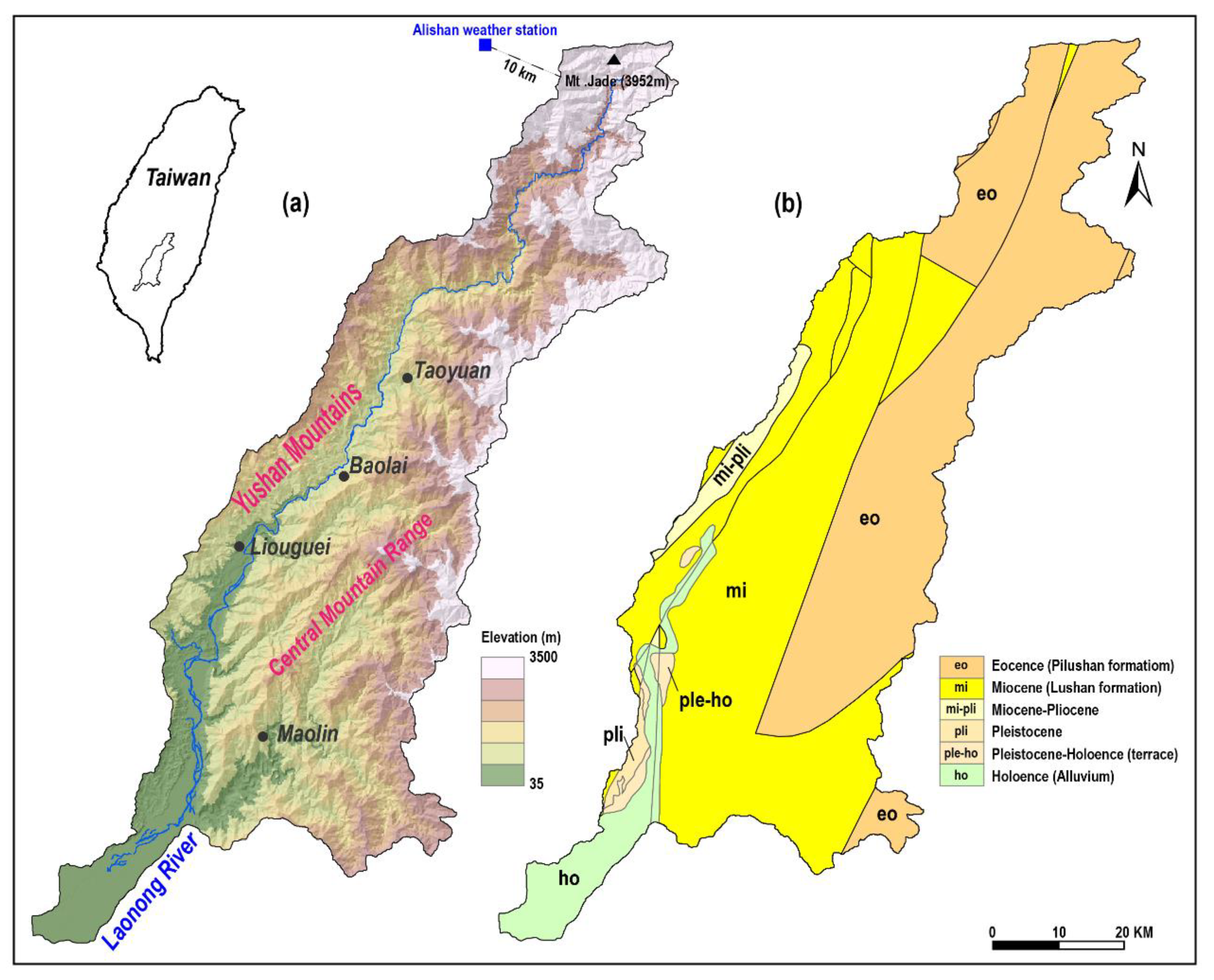
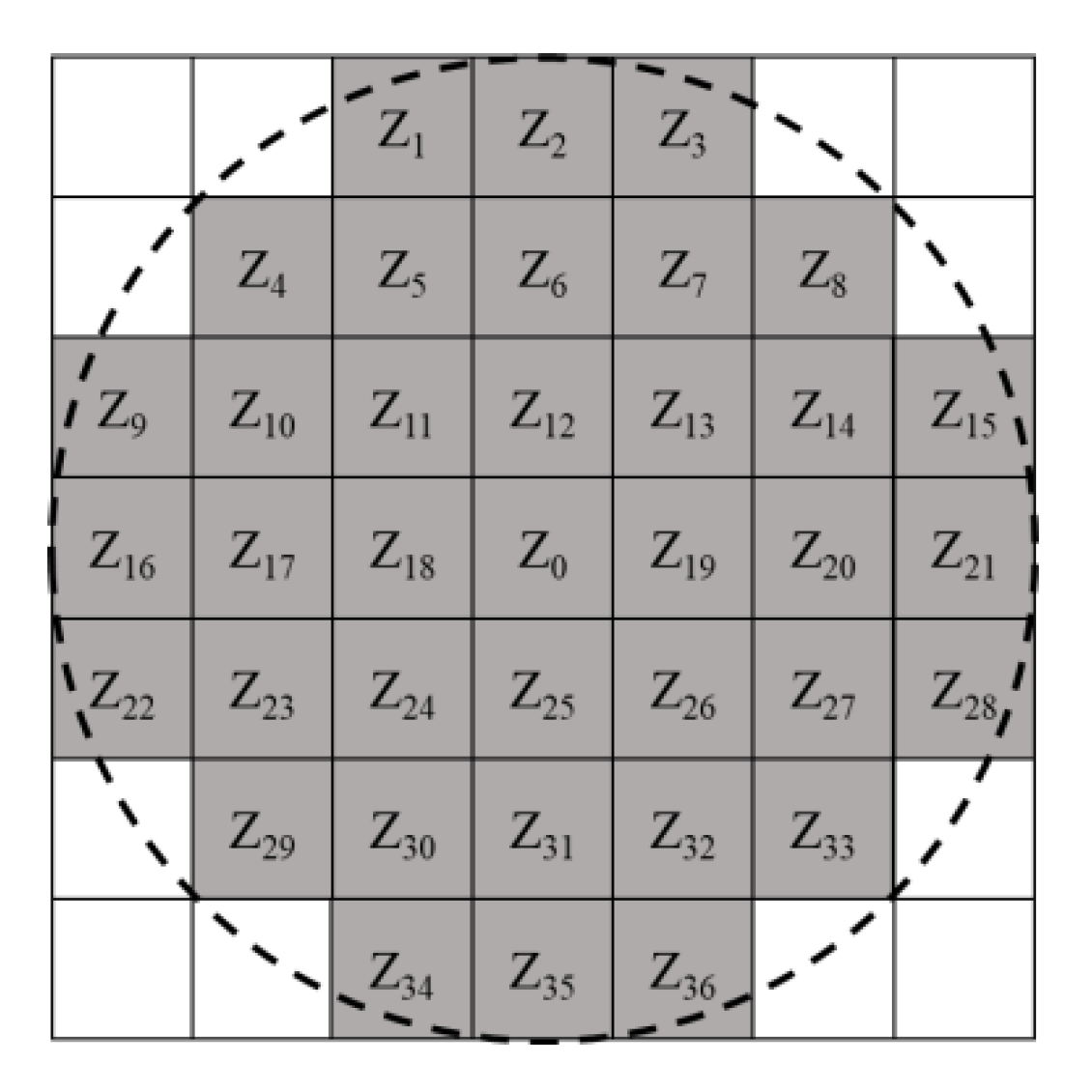
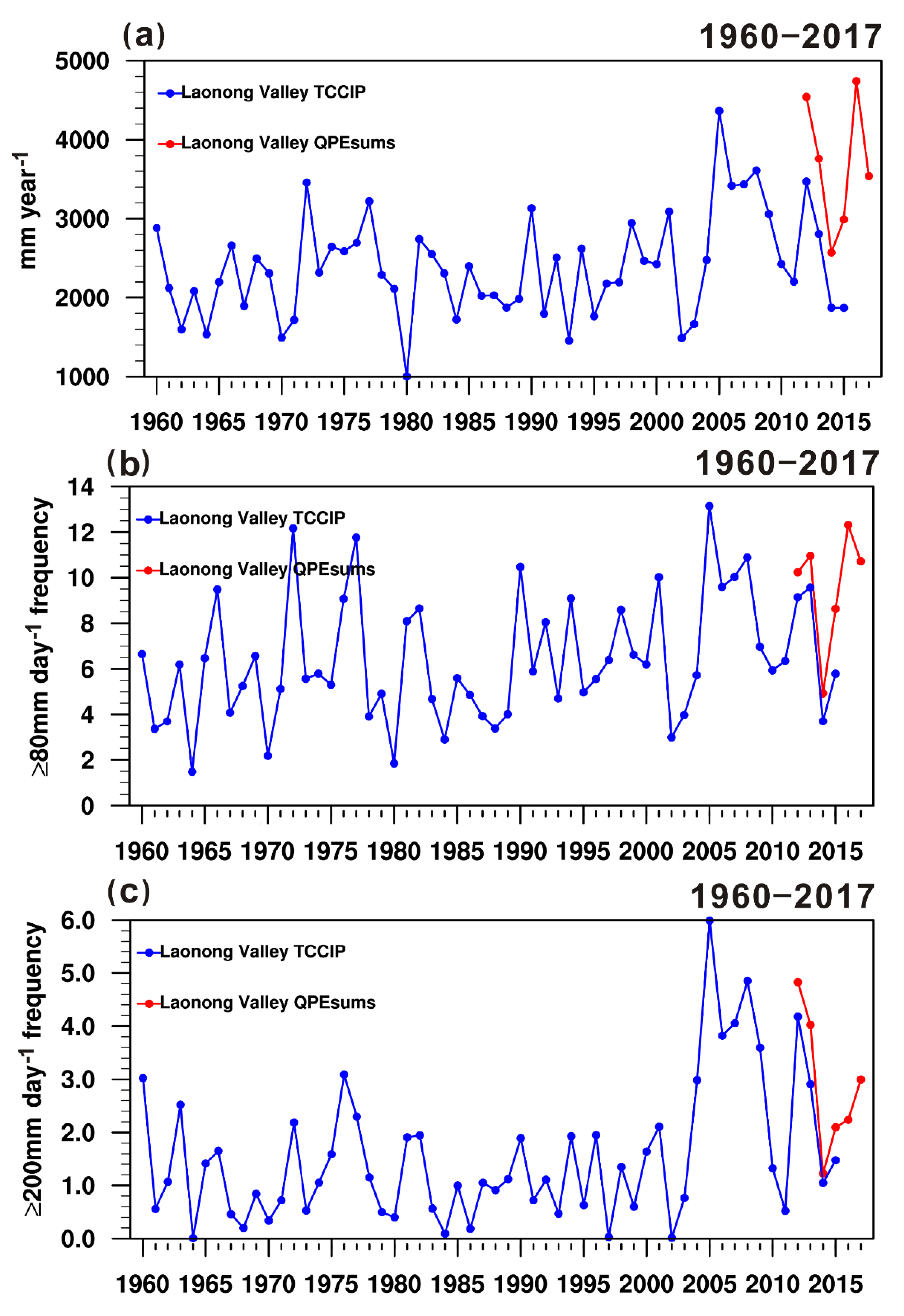
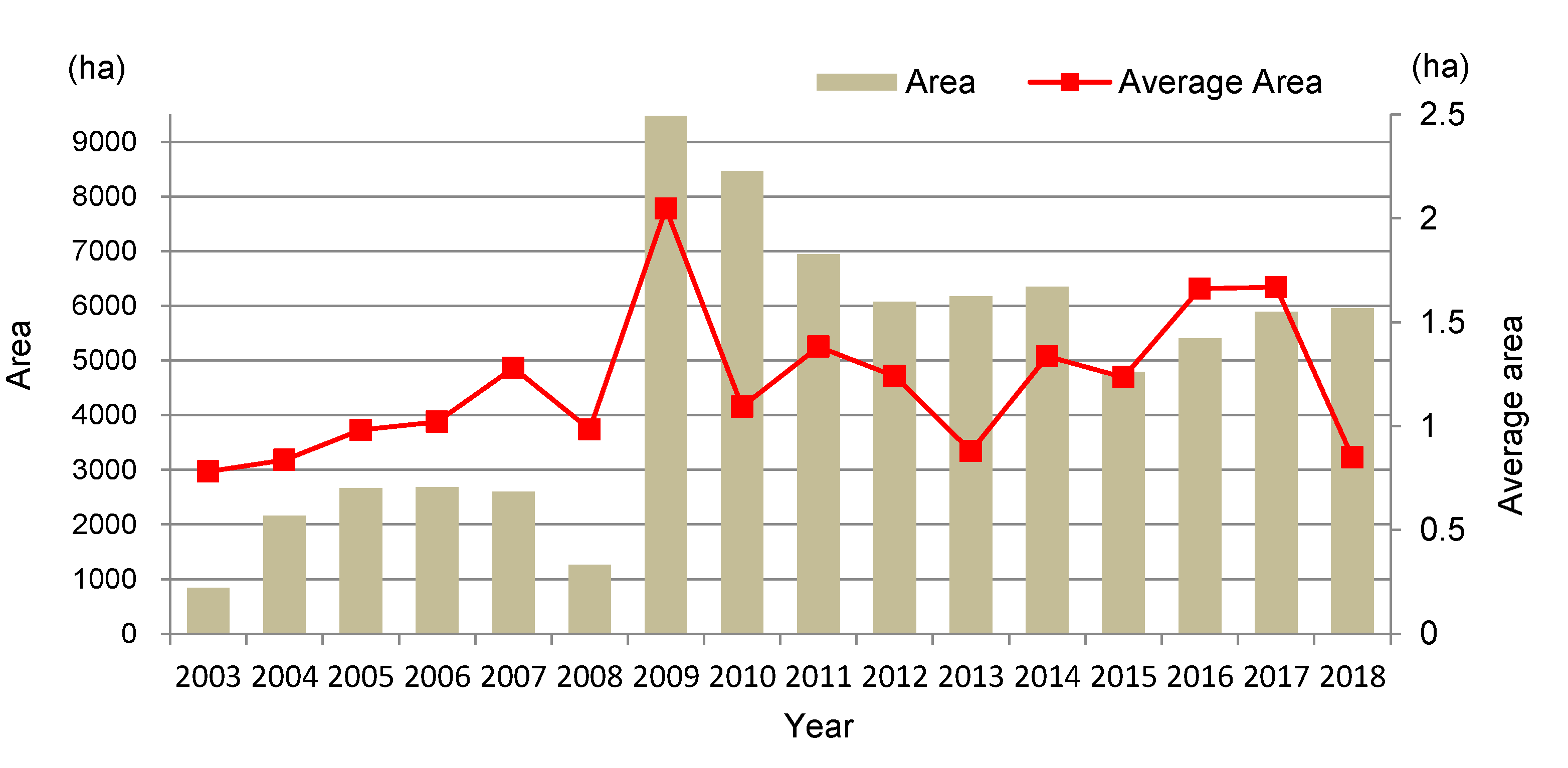
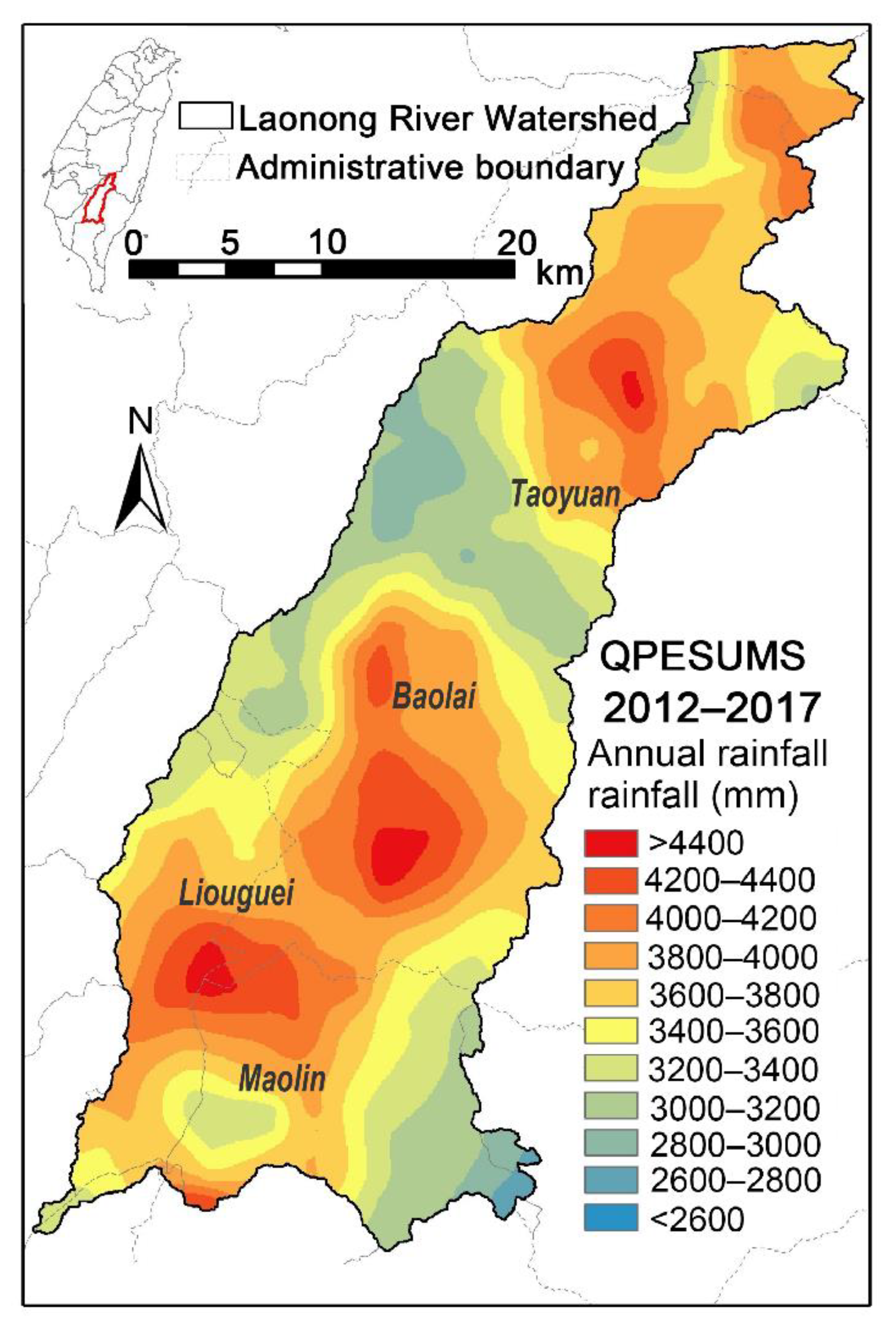



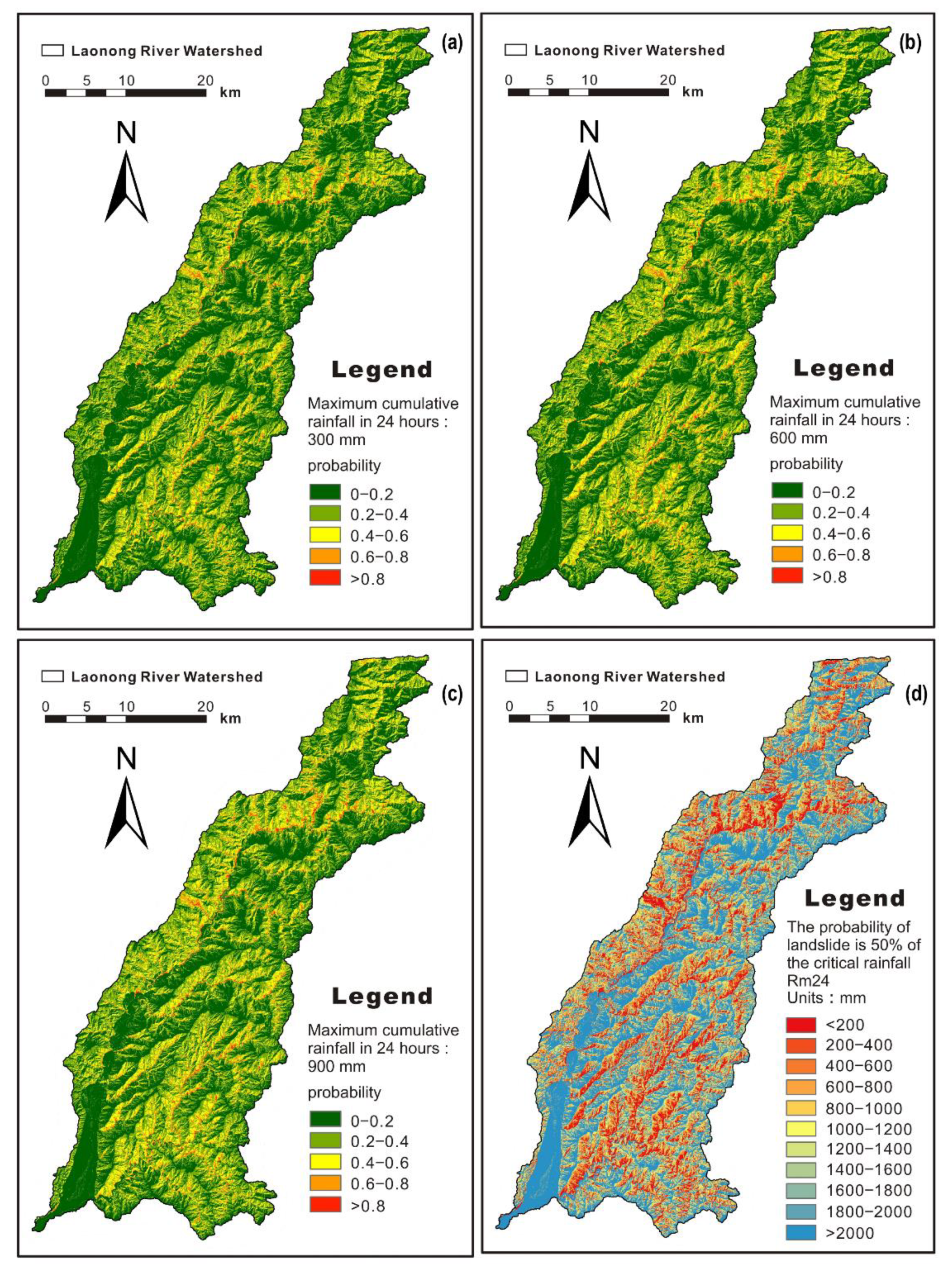

| Probability of Landslide | Risk Level |
|---|---|
| >0.8 | Serious |
| 0.6–0.8 | High |
| 0.4–0.6 | Moderate |
| 0.2–0.4 | Low |
| <0.2 | Slight |
| Year | Landslide Area (ha) | Proportion (%) | Count | Average Landslide Area (ha) |
|---|---|---|---|---|
| 2003 | 842.49 | 0.62 | 1063 | 0.78 |
| 2004 | 2155.56 | 1.58 | 2560 | 0.84 |
| 2005 | 2661.70 | 1.96 | 2694 | 0.98 |
| 2006 | 2677.86 | 1.97 | 2608 | 1.02 |
| 2007 | 2600.72 | 1.91 | 2020 | 1.28 |
| 2008 | 1266.00 | 0.93 | 1281 | 0.98 |
| 2009 | 9472.67 | 6.96 | 4615 | 2.05 |
| 2010 | 8467.19 | 6.22 | 7337 | 1.09 |
| 2011 | 6946.50 | 5.11 | 4998 | 1.38 |
| 2012 | 6069.76 | 4.46 | 4861 | 1.24 |
| 2013 | 6177.93 | 4.54 | 6685 | 0.88 |
| 2014 | 6352.23 | 4.67 | 4717 | 1.34 |
| 2015 | 4786.04 | 3.52 | 3855 | 1.24 |
| 2016 | 5401.57 | 3.97 | 3248 | 1.66 |
| 2017 | 5890.22 | 4.33 | 3527 | 1.67 |
| 2018 | 5951.46 | 4.38 | 5360 | 0.85 |
| Tested Model | Parameters | β value | S.E, | Wald | Sig. | Exp(β) |
|---|---|---|---|---|---|---|
| 2005 | Slope | 0.040 | 0.003 | 199.911 | 0.000 | 1.040 |
| Aspect of sin | 0.544 | 0.038 | 209.682 | 0.000 | 1.724 | |
| Aspect of cosine | −0.541 | 0.038 | 202.804 | 0.000 | 0.582 | |
| Topographic wetness index | 9.136 | 0.014 | 97.286 | 0.000 | 1.146 | |
| Distance to river | −0.001 | 0.000 | 177.706 | 0.000 | 0.999 | |
| Previous NDVI | −7.108 | 0.180 | 1561.588 | 0.000 | 0.001 | |
| Continuous maximum 24-hourly rainfall | 0.001 | 0.000 | 39.043 | 0.000 | 1.001 | |
| Geology | 268.817 | 0.000 | ||||
| Constant | −0.260 | 0.282 | 0.853 | 0.356 | 0.771 | |
| 2009 | Elevation | −3.34 × 10−4 | 0.000 | 64.078 | 0.000 | 1.000 |
| Slope | 0.032 | 0.002 | 227.551 | 0.000 | 1.032 | |
| Aspect of sin | 0.730 | 0.027 | 745.453 | 0.000 | 2.075 | |
| Aspect of cosine | −1.019 | 0.030 | 1162.476 | 0.000 | 0.361 | |
| Distance to river | −0.001 | 0.000 | 140.098 | 0.000 | 0.999 | |
| Topographic wetness index | 0.211 | 0.010 | 443.191 | 0.000 | 1.235 | |
| Previous NDVI | 0.002 | 0.000 | 44.848 | 0.000 | 1.002 | |
| Continuous maximum 24 hourly rainfall | −0.728 | 0.115 | 40.142 | 0.000 | 0.483 | |
| Geology | 535.879 | 0.000 | ||||
| Constant | −3.251 | 0.350 | 86.235 | 0.000 | 0.039 | |
| Mixed | Elevation | −2.28 × 10−4 | 0.000 | 38.028 | 0.000 | 1.000 |
| Slope | 0.049 | 0.005 | 115.588 | 0.000 | 1.050 | |
| Terrain roughness | −0.008 | 0.003 | 8.245 | 0.004 | 0.992 | |
| Aspect of sin | −0.571 | 0.025 | 532.984 | 0.000 | 1.769 | |
| Aspect of cosine | −0.903 | 0.027 | 1084.046 | 0.000 | 0.405 | |
| Distance to river | −4.93 × 10−4 | 0.000 | 120.778 | 0.000 | 1.000 | |
| Topographic wetness index | 0.194 | 0.009 | 435.909 | 0.000 | 1.214 | |
| Previous NDVI | 0.000 | 0.000 | 9.400 | 0.002 | 1.000 | |
| Continuous maximum of 24-hourly rainfall | −2.238 | 0.078 | 815.912 | 0.000 | 0.107 | |
| Geology | 484.502 | 0.000 | ||||
| Constant | −1.594 | 0.198 | 65.137 | 0.000 | 0.203 |
| 2005 Tested Model | |||
| Observed value | Predicted value | ||
| Non-landslide | Landslide | Percent accuracy (%) | |
| Non-landslide | 4114 | 886 | 82.28 |
| Landslide | 1336 | 3664 | 73.28 |
| Overall accuracy (%) | 77.78 | ||
| AUC for 2005 (calibration) | 0.895 | ||
| AUC for 2009 (validation) | 0.619 | ||
| 2009 Tested Model | |||
| Observed value | Predicted value | ||
| Non-landslide | Landslide | Percent accuracy (%) | |
| Non-landslide | 5479 | 2521 | 68.49 |
| Landslide | 1940 | 6060 | 75.75 |
| Overall accuracy (%) | 72.12 | ||
| AUC for 2005 (validation) | 0.639 | ||
| AUC for 2009 (calibration) | 0.788 | ||
| Mixed Tested Model | |||
| Observe value | Predicted value | ||
| Non-landslide | Landslide | Percent accuracy (%) | |
| Non-landslide | 6280 | 2720 | 69.78 |
| Landslide | 2714 | 6286 | 69.84 |
| Overall accuracy (%) | 69.81 | ||
| AUC for 2005 (calibration) | 0.811 | ||
| AUC for 2009 (calibration) | 0.772 | ||
| Risk Level | 300 mm | 600 mm | 900 mm | |||
|---|---|---|---|---|---|---|
| Area (m2) | Ratio (%) | Area (m2) | Ratio (%) | Area (m2) | Ratio (%) | |
| Slight | 114,693.90 | 84.32 | 105,002.14 | 77.19 | 90,025.42 | 66.18 |
| Low | 121,30.90 | 8.92 | 18,398.50 | 13.53 | 28,030.10 | 20.61 |
| Moderate | 3827.80 | 2.81 | 5725.76 | 4.21 | 8877.96 | 6.53 |
| High | 2619.56 | 1.93 | 3202.48 | 2.35 | 4294.92 | 3.16 |
| Serious | 2753.64 | 2.02 | 3696.92 | 2.72 | 4797.40 | 3.53 |
| Risk Level | 300 mm | 600 mm | 900 mm | |||
|---|---|---|---|---|---|---|
| Area (m2) | Ratio (%) | Area (m2) | Ratio (%) | Area (m2) | Ratio (%) | |
| Slight | 62,596.74 | 46.02 | 58,465.12 | 42.98 | 54,292.16 | 39.91 |
| Low | 47,089.60 | 34.62 | 47,831.00 | 35.16 | 48,456.60 | 35.62 |
| Moderate | 20,203.90 | 14.85 | 22,658.60 | 16.66 | 25,081.60 | 18.44 |
| High | 5127.64 | 3.77 | 5878.16 | 4.32 | 6785.92 | 4.99 |
| Serious | 1007.92 | 0.74 | 1192.92 | 0.88 | 1409.52 | 1.04 |
Publisher’s Note: MDPI stays neutral with regard to jurisdictional claims in published maps and institutional affiliations. |
© 2020 by the authors. Licensee MDPI, Basel, Switzerland. This article is an open access article distributed under the terms and conditions of the Creative Commons Attribution (CC BY) license (http://creativecommons.org/licenses/by/4.0/).
Share and Cite
Tseng, C.-W.; Song, C.-E.; Wang, S.-F.; Chen, Y.-C.; Tu, J.-Y.; Yang, C.-J.; Chuang, C.-W. Application of High-Resolution Radar Rain Data to the Predictive Analysis of Landslide Susceptibility under Climate Change in the Laonong Watershed, Taiwan. Remote Sens. 2020, 12, 3855. https://doi.org/10.3390/rs12233855
Tseng C-W, Song C-E, Wang S-F, Chen Y-C, Tu J-Y, Yang C-J, Chuang C-W. Application of High-Resolution Radar Rain Data to the Predictive Analysis of Landslide Susceptibility under Climate Change in the Laonong Watershed, Taiwan. Remote Sensing. 2020; 12(23):3855. https://doi.org/10.3390/rs12233855
Chicago/Turabian StyleTseng, Chun-Wei, Cheng-En Song, Su-Fen Wang, Yi-Chin Chen, Jien-Yi Tu, Ci-Jian Yang, and Chih-Wei Chuang. 2020. "Application of High-Resolution Radar Rain Data to the Predictive Analysis of Landslide Susceptibility under Climate Change in the Laonong Watershed, Taiwan" Remote Sensing 12, no. 23: 3855. https://doi.org/10.3390/rs12233855
APA StyleTseng, C.-W., Song, C.-E., Wang, S.-F., Chen, Y.-C., Tu, J.-Y., Yang, C.-J., & Chuang, C.-W. (2020). Application of High-Resolution Radar Rain Data to the Predictive Analysis of Landslide Susceptibility under Climate Change in the Laonong Watershed, Taiwan. Remote Sensing, 12(23), 3855. https://doi.org/10.3390/rs12233855





